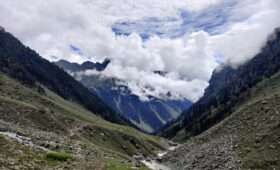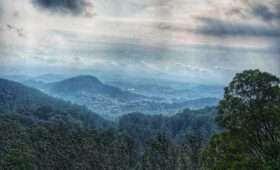A keen hiker is not excused by the monsoons. He knows the best hiking advice for the monsoon, so why would it be? Monsoon season wilderness exploration offers a unique experience. Green colours become more vivid. You get to see unusual plants and animals. Additionally, the trails get cleaner and prettier. On the vibrantly green canvas, the blossoms give a punch of colour. The colourful views of the Himalayas that are only visible during the monsoons may be admired on monsoon treks in India.
Being prepared is essential for having a wonderful monsoon hiking experience. Being ready entails taking all essential precautions to minimize any discomfort throughout the voyage. Here are a few monsoon trekking recommendations that you should consider before setting out on your expedition.
Always keep a rain cover and appropriate clothing handy.
You need to have a raincoat with you to protect yourself from the showers. Consequently, spend money on a high-quality raincoat. Either a poncho or a two-piece rain suit are options. Your bag will be kept dry with a poncho. Keep a heavy jacket on your hand as well for warmth in the evening. If they should wear capes or a rain jacket and pants, I get asked this question by many hikers. Because it is simpler to journey while wearing them, I would suggest a rain jacket and pants. For spring or summer hikes where rains are infrequent, ponchos work well. Ponchos won’t be very useful, though, if you’re anticipating a significant downpour that will last for many hours during the day. Your raincoat and pants should be of high quality (with at least 5,000 mm waterproofing).
Wrap everything in plastic bags before placing it in your backpack.
In heavy rain, your backpack’s rain cover won’t be of much use. Your backpack’s contents might become damp. Therefore, if you wrap everything in plastic, even if water seeps into your backpack, your clothes will stay dry. Additionally, you might compartmentalize your clothing and accessories in your bag using plastics. You won’t have to fumble with your possessions that way. You must be prevented from becoming wet, but not only you. Before you begin your walk, cover your bags with rain covers that you should have brought with you. Now, it is advisable to store commonly used goods outdoors, outside, during a rainy excursion. Plastic bags can also be used to separate the goods.
Don’t Wear Cotton Pants and Carry comfortable clothing
When going on a hike in the rainy season, avoid wearing cotton trousers. Water is absorbed by cotton. Therefore, it is better to use GORE-TEX hiking pants. Since they are somewhat expensive, you might go for nylon/spandex fabric that has quick-drying and air permeability qualities. To prevent mud stains from the puddles on your pants, you might choose short or 3-quarter length pants. For the monsoon and any other weather situations, convertible and roll-up pants are great options.
Comfortable slippers and water-resistant or waterproof footwear
To hike during the rainy season, it’s crucial to have the proper pair of monsoon trekking shoes with solid traction. Depending on the needs of your walk track, you can choose between waterproof shoes and extremely good trekking shoes. Our feet often suffer a great deal on monsoon treks. Let’s face it, even with water-resistant shoes, our feet would get a bit wet. Your skin would then be impacted by this, becoming itchy and eventually developing blisters. By using Vaseline on our feet before night, we may stop the natural oils from our feet. In between each walk, stop and allow your feet to breathe. Amphibian sandals are an additional option.
Take precautions against insects and pests.
Leeches and mosquitoes are expected during the monsoon season, but companion hikers are not. Take bug repellents for mosquitoes (in the lowlands) and a reliable leech-removal strategy (in the highlands) as these annoying travelling companions like warm, moist conditions. Even the hardest hiking boot can’t stop leeches from slipping through shoes, stockings, and other clothing. Avoid sitting on rocks or leaning against trees that haven’t been in full sunlight and spray insect repellent on your socks to protect yourself from an attack. The leech will bleed abundantly and leave a little lump if you attempt to peel it off if you are mistaken for lunch. Instead, you should put table salt on the leech to help it separate. Alternately, follow local customs and sprinkle Szechuan pepper on your shoes to deter leeches. Markets and grocery shops often have Szechuan pepper, also known as Himalayan fireberry or Timur in Nepali.
A waterproof tent should be closed up.
The waterproof material is typically used to construct tents. Even then, be sure your tent is resilient enough to withstand wind and rain. The tent’s groundsheet needs to be capable of withstanding water currents that flow hundreds of litres per second. Keep the tent’s zipper permanently closed and don’t let any water inside. You must prevent leeches and snakes out of your tent if you’re hiking in a tropical area. In fact, before entering your tent for the night, we advise checking all of its nooks and crannies to ensure that no shady characters have taken up residence.
Healthy food is very important during the monsoon.
You need to have robust immunity since there are many chances that you may get diarrhoea, fever, a cold, or cough during the monsoon. Consume a diet high in antioxidants and steer clear of fast food. It is very forbidden to eat uncooked food. Carry a lot of liquids to remain hydrated. Choose complex carbs, such as a banana or apple, to keep your energy balanced. Steer clear of greasy, spicy, and junk food. Avoid going overboard to avoid acid reflux and bloating. eat plenty of fibre, carbs, and high-quality protein. Eat rice and sauteed vegetables with lean chicken curry. Eat paneer or tofu with rice, whole wheat roti, multigrain roti, and sauteed vegetables if you’re a vegetarian. You can consume berries, as well as certain dry fruits and seeds while walking.



